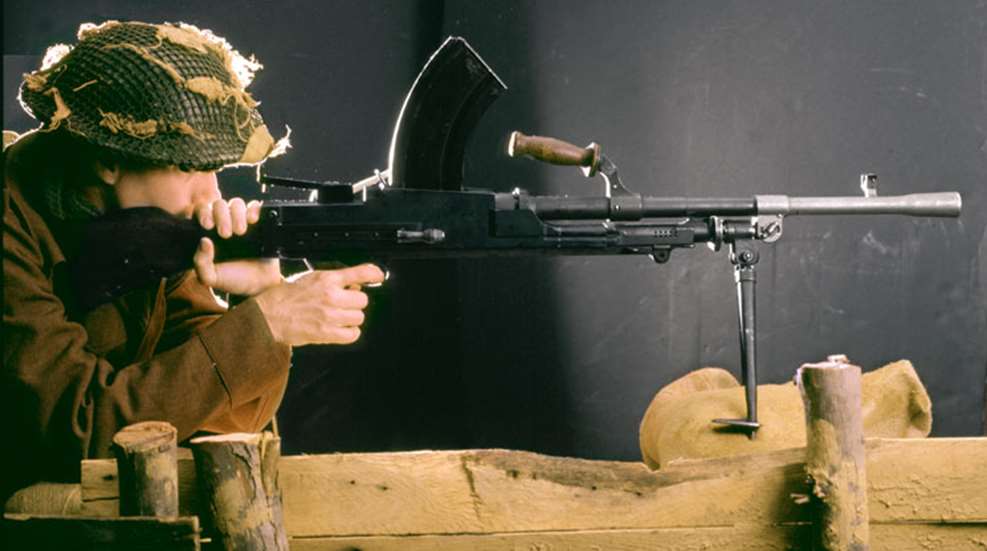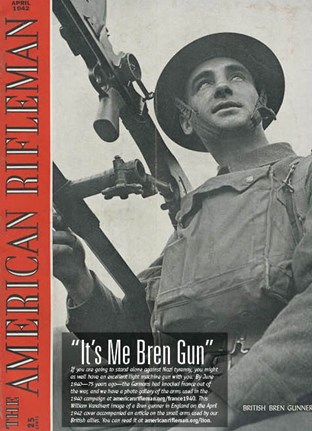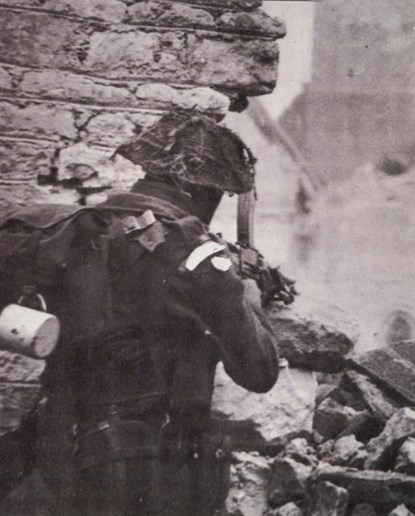

The otherwise conservative and destitute British Army took a very bold step in 1937. Since 1922, the British had been searching for a suitable light machine gun to replace its mainstay of the Great War, the Lewis gun. The Vickers Berthier Light machine gun was almost adopted, but a gun from the Czech firm of Brno won out on the eve of the Second World War. It became in 1937 the Bren Light Machine gun, Mark I, so named for the first two letters of Brno, and the first two letters of the Royal Small Arms factory Enfield. The Bren proved to the finest box-fed light machine gun of World War II, perhaps of all time. Calm down BAR fans, the BAR is just what its name implies—an automatic rifle—not a light machine gun.
While they clung to the bolt-action Lee-Enfield, the decision to adopt the Bren was as significant as the American adoption of the “U.S. Rifle, Caliber .30”—the M1 Garand. Indeed, because the Bren was so good, the British could afford a slightly improved version of the rifle carried by their grandfathers or great-grandfathers at Mafeking or Colenso during the Boer War. The Bren simply worked, and worked well. It had a robust, ingenious tilting block locking system. It had an adjustable gas system, so that it could fire even when fouled terribly by merely changing the gas port setting. It had a beefy, easily changed barrel, a very important feature for an air-cooled light machine gun—even though many times gunners heated them read and almost white hot before the barrels could be changed.

One of the advantages and chief disadvantages of the Bren was its top-mounted magazine, distinctively curved for the archaic, rimmed .303 British cartridges. Particular care had to be taken in loading the magazines, as stacking one rim before the other would result in a serious jam. But the top-mounted magazine allowed the firer to get low and prone.
That top-mounted magazine meant the sights had to be offset on the left side. Eye dominance be damned, Bren gunners had to fire from the right shoulder.
But the Bren could be also fired by the hip, and that’s what Corporal Billy Gray of D Company of the Ox & Bucks did in the early minutes D-Day during the glider-born coup de main by Major John Howard’s remarkable company of the 6th Airborne Division. “Someone threw a grenade at the machine gun to the right. Gray fired toward a sentry with a very pistol, then fired on the other gun pit, along with others, knocked out the machine gun.” The vital bridge was secure, in no small part to Billy Gray and his Bren.
As with just about every other small arm used by the British during World War II, the most beautiful Brens ever made—beyond the almost lovingly hand built pre-war Mark Is—were those made by John Inglis & sons in Canada. The same goes for Longbranch Stens and No. 4 rifles. It seems that not having bombs dropping on your factory gives you the time to put a nice polish and blue on.
Most of the changes to the Bren over the course of its production had to do with simplifying manufacture with the elimination of niceties such as the elaborate sights, the rear monopod and the complex flash hider. The Bren was an extremely difficult arm to produce, as the receiver alone required 261 machining operations. In Normandy, the majority of guns appear to Mark IIs, although the recess for the monopod and the Mark I rear sight do turn up quite often.
Smalls arms authority the late Ian Hogg, in his rather blunt style had this to say: "The Bren Gun is spoken of with affection by every British soldier who ever used one, and with good reason. Beyond any doubt it was . . . the finest light machine gun ever adopted in quantity by any army. It was reliable, robust, simple and accurate, and beyond that no one has a right to ask."
Just how good was Bren? Nearly 40 years after D-Day, when the British went to war with Argentina in 1982 and took back the Falklands, they took their Brens rechambered to 7.62 mm with them.
Bren Light Machine Gun Mark I
Operation: gas-operated, tilting-bolt, selective-fire, machine gun
Caliber: 3030 British
Weight: 22.12 lbs.
Overall Length: 45.5”
Barrel length: 25”
Rifling: six-groove, RH twist
Cyclic rate: 500 rounds per minute
Realistic Rate: 100 to 120 rounds per minute
Magazine: detachable box, 32-round capacity, staggered column (works best with 28 or 29)
Bullet Weight: 174 grains (Mk VII SAA)
Bullet Velocity: 2440 fps
Effective Range: 1,000 yards
Maximum Range: 3,500 yards
Manufacturers:
Zbrojovka Brno Prototypes
RSAF Enfield Mk I, Mk II, Mk III, Mk IV Monotype Group Mk I, MK II
John Inglis & Co., Canada Mk I, Mk II
Lithgow Small Arms Factory, Australia
Total Produced: 337, 000 (estimated)





































